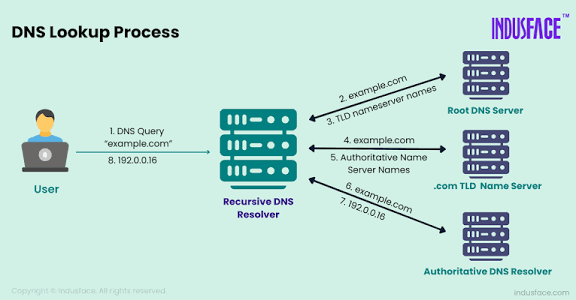
DNS Lookup
Created on 16 September, 2025 • Checker tools • 97 views • 4 minutes read
DNS Lookup: A Complete Guide to Understanding Domain Name System Queries
DNS Lookup: A Complete Guide to Understanding Domain Name System QueriesIntroduction to DNS Lookup
The internet is an interconnected network of millions of devices, websites, and servers. Every website you visit is associated with an IP address, a unique string of numbers that identifies a device on the internet. However, remembering IP addresses for every website would be impractical. This is where the Domain Name System (DNS) comes into play.
A DNS lookup is the process of translating a human-readable domain name like example.com into its corresponding IP address. This process allows your browser to locate the server hosting the website you want to visit. Understanding DNS lookup is essential for IT professionals, website owners, and anyone interested in how the internet functions.
What is DNS?
Understanding the Domain Name System
The Domain Name System (DNS) acts like the phonebook of the internet. It translates easy-to-remember domain names into IP addresses that computers use to communicate with each other. For example, typing www.google.com in your browser triggers a DNS lookup to find Google's server IP address.
Importance of DNS
DNS is crucial for several reasons:
Simplifies browsing by replacing IP addresses with readable names.
Ensures reliable routing of internet traffic.
Enhances website performance through caching.
Supports email delivery, VPN connections, and other network services.
How Does DNS Lookup Work?
Step 1: Browser Request
When you type a domain name in your browser, the first step is a DNS query. Your browser checks its cache to see if the IP address of the domain is already stored.
Step 2: Operating System Cache
If the browser cache does not have the record, the query moves to your computer’s OS cache. Operating systems store recently accessed DNS records to speed up subsequent visits.
Step 3: Recursive DNS Resolver
If the OS cache misses, the query is sent to a recursive DNS resolver—usually provided by your Internet Service Provider (ISP). The resolver’s job is to find the authoritative DNS server that can provide the correct IP address.
Step 4: Root Name Servers
The recursive resolver first contacts a root name server to identify the top-level domain (TLD) server, such as .com or .org, that knows where the domain is hosted.
Step 5: TLD Name Servers
Next, the resolver contacts the TLD server, which points to the authoritative name server for the specific domain.
Step 6: Authoritative DNS Server
Finally, the query reaches the authoritative DNS server for the domain. This server responds with the correct IP address.
Step 7: Response Back to Browser
The IP address is returned to the resolver, which sends it to your browser. The browser can now connect to the website's server and load the content.
Types of DNS Records
Understanding different DNS records is vital for webmasters and IT professionals. Here are the most common types:
A Record (Address Record)
Maps a domain name to an IPv4 address.
AAAA Record
Maps a domain name to an IPv6 address.
CNAME Record (Canonical Name)
Points a domain name to another domain name.
MX Record (Mail Exchange)
Specifies the mail server responsible for receiving email.
TXT Record
Contains arbitrary text information for various purposes, including SPF, DKIM, and domain verification.
NS Record (Name Server)
Specifies the authoritative name servers for the domain.
PTR Record
Maps an IP address to a domain name (reverse DNS lookup).
Tools for DNS Lookup
Several tools allow you to perform DNS lookups easily:
nslookup
nslookup is a command-line tool used to query DNS records. It is available on Windows, macOS, and Linux.
Example:
nslookup example.com
dig
dig (Domain Information Groper) is a versatile DNS lookup tool, mainly used on Linux and macOS.
Example:
dig example.com
Online DNS Lookup Tools
Websites like dnschecker.org or mxtoolbox.com provide browser-based DNS lookup services.
Why DNS Lookup is Important
Website Troubleshooting
DNS lookup helps identify whether a website’s domain is correctly pointing to its IP address.
Network Diagnostics
System administrators use DNS queries to diagnose network issues.
SEO and Website Performance
Incorrect DNS configuration can result in slow website loading, affecting SEO rankings and user experience.
Security Monitoring
DNS lookup can detect malicious domains or spoofed websites.
Common DNS Lookup Issues
DNS Propagation Delay
Changes to DNS records can take 24–48 hours to propagate globally.
DNS Cache Poisoning
A malicious attack where the DNS cache is altered to redirect users to fake websites.
Incorrect DNS Configuration
Errors in DNS records can result in websites being inaccessible.
Server Downtime
If the authoritative DNS server is down, the DNS lookup will fail.
Tips for Optimizing DNS
Use a reliable DNS provider like Cloudflare, Google DNS, or OpenDNS.
Enable DNS caching to reduce lookup times.
Monitor DNS records regularly to prevent misconfigurations.
Secure DNS with DNSSEC (Domain Name System Security Extensions).
Conclusion
A DNS lookup is a fundamental process that enables seamless internet browsing. From translating domain names into IP addresses to maintaining network security and website performance, DNS plays a critical role in internet infrastructure. By understanding DNS records, lookup tools, and potential issues, website owners, IT professionals, and everyday users can ensure faster, safer, and more reliable internet experiences.
Whether you are troubleshooting your website, optimizing for SEO, or learning about internet networking, mastering DNS lookup is essential.
Popular posts
-
Random number generatorGenerator tools • 133 views
-
Emojis removerText tools • 129 views
-
Lorem Ipsum generatorGenerator tools • 129 views
-
Reverse lettersText tools • 121 views
-
Old English text generatorText tools • 121 views